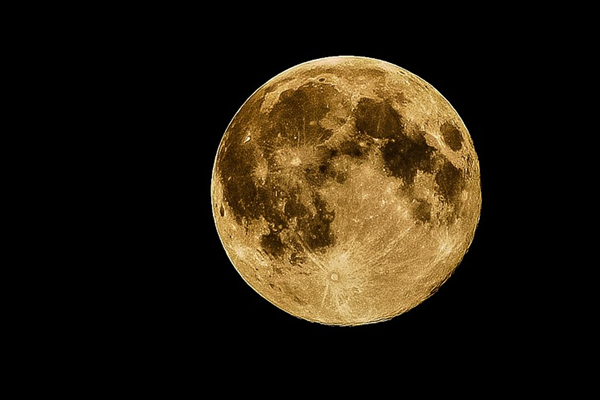
Friday, April 28
The Moon reaches apogee, the farthest point from Earth in its orbit, at 2:43 A.M. EDT, when it will lie 251,220 miles (404,300 km) from our planet.
Venus and Mars continue to dominate the western sky after sunset. Venus is unmissable at magnitude –4.1, hanging just below the star Elnath in Taurus. Elnath marks the tip of one of the Bull’s two horns — to its south is Alheka, the tip of the other horn. Memorize this scene — Venus will quickly travel upward and pass between the two horntips over the next few days.
Mars, meanwhile, shines at magnitude 1.3 in Gemini, sitting below golden-hued Pollux, which marks one of the Twins’ heads. The other is blue-white Castor to Pollux’s right. Mars, too, will move noticeably over the next few days; on May 2nd, it will add an extra point of light on a line drawn between magnitude 3.5 Wasat and 1st-magnitude Pollux, sitting slightly closer to the former.
This week is also one of your last good chances to enjoy evening sights such as the great Orion Nebula (M42). Look left of Taurus and below Gemini to find the familiar hourglass shape of Orion the Hunter, noting the three stars that form his famous belt. South of the easternmost star (Alnitak) is the Orion Nebula, often visible to the naked eye as a dim, fuzzy patch of light. You’ll definitely want to turn a telescope on this region to enjoy the wispy detail of this much-beloved star-forming region. The earlier you look after dark, the better, because the nebula will be higher and less muddled by the turbulence that rules the air near the ground.
Sunrise: 6:04 A.M.
Sunset: 7:52 P.M.
Moonrise: 12:48 P.M.
Moonset: 3:01 A.M.
Moon Phase: Waxing gibbous (58%)
*Times for sunrise, sunset, moonrise, and moonset are given in local time from 40° N 90° W. The Moon’s illumination is given at 12 P.M. local time from the same location.
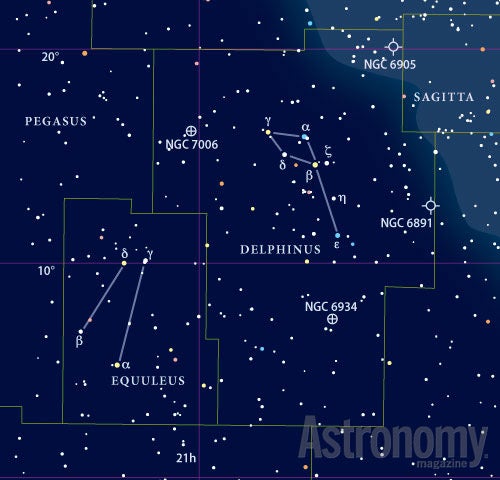
Saturday, April 29
The tiny constellation Delphinus the Dolphin is high in the southeast an hour or two before sunrise this morning. All you need to do is step outside and look up for a small diamond shape of stars about 15° east of bright Altair in Aquila. The brightest (magnitude 3.6), which forms the western point of the diamond, is actually Delphinus’ beta star. Slightly fainter (magnitude 3.8) Alpha (α) Delphini lies 1.5° to its north. From there, moving counterclockwise, are 5th-magnitude (γ) Delphini and 4th-magnitude Delta (δ) Delphini. About 3.5° south of Beta is 4th-magnitude Epsilon (ϵ) Delphini, the Dolphin’s tail.
If you drop another 4° south of Epsilon using binoculars or a small scope, you’ll discover 9th-magnitude NGC 6934, a compact globular cluster spanning about 8′.
Sunrise: 6:03 A.M.
Sunset: 7:53 P.M.
Moonrise: 1:51 P.M.
Moonset: 3:29 A.M.
Moon Phase: Waxing gibbous (67%)
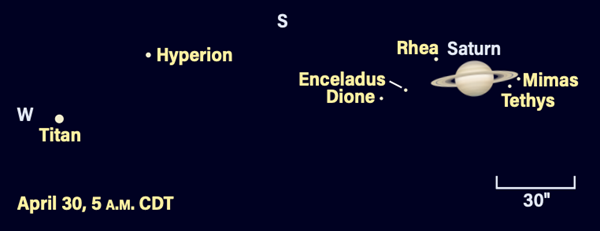
Sunday, April 30
Saturn and its moons make a great target in the eastern sky early this morning. The ringed planet’s largest moon, Titan, sits nearly 3′ due west of Saturn today and shines at 8th magnitude. Saturn itself is magnitude 0.9, located in Aquarius just 0.4° from 5th-magnitude Sigma (σ) Aquarii. Through a telescope, Saturn’s disk spans 16″ and its rings appear relatively thin, tilted just 9° to our line of sight. They will continue to narrow as that angle shrinks over the next few months, so now is a great time to get in some good observing. Try around 5 A.M. or so, when the region housing the planet has had time to rise a bit but the sky isn’t yet too bright with the coming dawn.
Aquarius isn’t the most recognizable constellation; see if instead you can locate the large Square of Pegasus asterism, which lies northeast of Saturn’s position. Its four corners are marked by the stars Markab, Algenib, Alpheratz, and Scheat.
Asteroid 7 Iris reaches opposition at noon EDT. It currently lies at the border of Virgo and Libra and will be visible all night at 10th magnitude — catchable with a good pair of binoculars or a telescope. Tonight, the asteroid sits just 1.5′ from a field star of the same magnitude — if you’re able to separate them, Iris is the easternmost object.
Sunrise: 6:02 A.M.
Sunset: 7:54 P.M.
Moonrise: 2:52 P.M.
Moonset: 3:54 A.M.
Moon Phase: Waxing gibbous (76%)
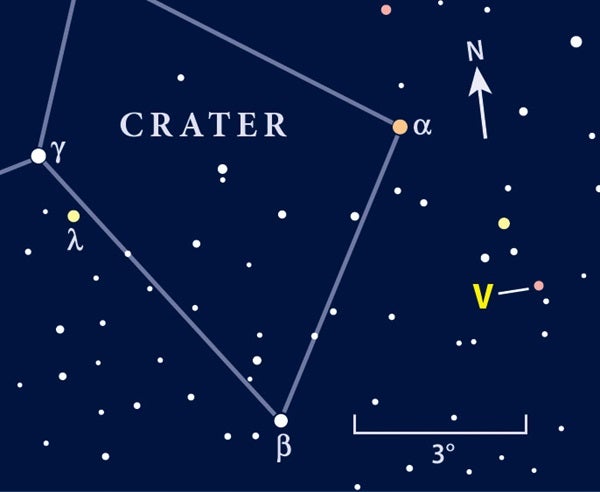
Monday, May 1
Mercury is in inferior conjunction at 7 P.M. EDT. Although the solar system’s smallest, speediest planet is now behind the Sun from our point of view, it will emerge from our star’s glare before the end of the month.
Let’s open the month of May by observing the stunning red carbon star V Hydrae. Located in Hydra the Water Snake, this star lies due south an hour after sunset, some 30° high. It remains visible all evening to the far upper right of bright Sirius in Canis Major the Big Dog.
To locate V Hydrae, it’s actually easier to use the next constellation over, Crater the Cup. First, find 4th-magnitude Alkes (Alpha Crateris), then scan about 3.5° southwest to land on V Hya. You can’t miss its deep crimson color, caused by vast amounts of carbon in this star’s atmosphere. Carbon preferentially scatters away the star’s shorter-wavelength light (such as blue and yellow), leaving only the red light to reach our eyes and scopes here on Earth. This is why carbon stars such as this always appear notably red.
V Hya is also a well-known variable star. Over the course of about a year and a half, V Hya changes magnitude from 6.6 to 9 and back again. So, it can appear much brighter at certain times than others! Compare it to its neighbors — this chart from the American Association of Variable Star Observers — gives the brightness of nearby stars, rounded to the nearest tenth of a magnitude. Note these numbers lack decimal points, so a magnitude on the chart of “45” is actually “4.5.” V Hya is indicated on the chart by the white circle and crosshairs.
Sunrise: 6:00 A.M.
Sunset: 7:55 P.M.
Moonrise: 3:54 P.M.
Moonset: 4:15 A.M.
Moon Phase: Waxing gibbous (84%)
Tuesday, May 2
Pluto stands stationary against the background stars at 7 P.M. EDT. Now an early-morning object, the dwarf planet is located in Capricornus. At 14th magnitude, you’ll need a large aperture to spot its tiny disk, which will appear as a slightly “flat” star.
Pluto rises shortly before 2 A.M. local time; you’ll want to give it a few hours to climb as high above the horizon as possible (and for the waxing Moon to sink as low as possible) before the sky begins to lighten. Try around 4 A.M., when Pluto is 20° high in the southeast. Finding the tiny planet can be difficult, but fortunately, there’s a good signpost nearby: Globular cluster M75 in Sagittarius lies less than 1.5° away. Pluto sits southeast of this magnitude 8.5 cluster — so, once you find M75, drop in an eyepiece that gives a 1.5°–2° field of view, place the cluster on the northwest edge of your field, and look for the tiny dot of Pluto to the southeast.
M75 itself is a great target, particularly if Pluto is frustrating you. This compact ball of ancient stars sits some 67,500 light-years away and spans nearly 7′ in your eyepiece, corresponding to a physical size of about 130 light-years.
Sunrise: 5:59 A.M.
Sunset: 7:56 P.M.
Moonrise: 4:56 P.M.
Moonset: 4:36 A.M.
Moon Phase: Waxing gibbous (90%)
Wednesday, May 3
One of the sky’s most beautiful double stars is visible overnight. Located in Cygnus the Swan, Albireo (Beta [β] Cygni) is a colorful two-for-one deal that is sure to dazzle. Rising around 10 P.M. local time, you’ll want to give Albireo a chance to climb out of the turbulent air near the horizon for the best views. Look northeast just before midnight or into early tomorrow morning, and you’ll easily find the cross-shaped Cygnus flying through the skies. The Swan’s brightest star is magnitude 1.3 Deneb, which lies in the northern portion of the constellation and marks the bird’s tail. In the southern region is 3rd-magnitude Albireo, representing its head.
Although it looks like just one star to the naked eye, Albireo can be split into two using large (ideally mounted) binoculars or any small scope. When you do, you’ll immediately notice its two components — separated by about 34″ — are markedly different colors. The brighter primary star shines at 3rd magnitude and gives off a soft, golden light. Its dimmer (5th-magnitude) companion is much hotter, rendering its light a blue-white in color. Although Albireo A (the brighter, golden star) is itself a double, its components are not readily discernible in amateur instruments.
Cygnus will continue rising earlier each night, until the Swan flies high overhead by midnight during the summer season.
Sunrise: 5:58 A.M.
Sunset: 7:57 P.M.
Moonrise: 6:01 P.M.
Moonset: 4:58 A.M.
Moon Phase: Waxing gibbous (95%)
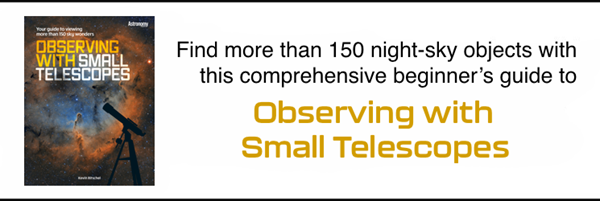
Thursday, May 4
Let’s explore the bright open clusters in Auriga before this wintertime constellation disappears from the evening sky.
An hour after sunset, you’ll find this constellation about 30° high in the west, marked by its brightest star, magnitude 0.1 Capella. It’s located to the upper right of bright Venus (in far northeastern Taurus) in the darkening sky.
All three of our target clusters lie in southern Auriga. Closest to Capella is M38, some 10.5° south of the star and about halfway on a line drawn between Iota (ι) and Theta (θ) Aurigae. M38 shines at magnitude 7.4, requiring binoculars or a small telescope to spot. It spans about 20′ and many observers think its brightest stars form the rough shape of the Greek letter pi (π).
Just over 2° southeast of M38 is our next cluster, M36. At magnitude 6.3, it might be just visible to the naked eye if you have good eyesight, clear weather, and a dark observing site. M36 is much more compact, roughly half the size of M38, and contains at least 60 stars.
From M36, jump about 3.5° east to land on our last cluster, M37. Much richer than the previous two, M37 hosts some 500 suns and spans about 24′. It’s roughly the same brightness as M36 — magnitude 6.2 — and hosts several red giant stars, meaning it’s actually a relatively “old” young open cluster. Astronomers estimate it is about 300 million years old.
Sunrise: 5:57 A.M.
Sunset: 7:58 P.M.
Moonrise: 7:08 P.M.
Moonset: 5:21 A.M.
Moon Phase: Waxing gibbous (99%)
Friday, May 5
Full Moon occurs at 1:34 P.M. EDT. You’ll find the Flower Moon — the colloquial name for May’s Full Moon — rising in the east right around sunset, as Luna lies opposite the Sun when it is Full.
Following the recent solar eclipse, tonight brings us a penumbral lunar eclipse. This event is not as dramatic as a “normal” lunar eclipse, when the Moon turns an orangey-red as it passes through the darker, central portion of Earth’s shadow. Instead, penumbral eclipses occur when Luna slides through the outer region of our planet’s shadow, resulting in a much more subtle effect.
The eclipse is not visible from the U.S., but instead will occur this evening over Africa, Asia, Australia, and New Zealand. Greatest eclipse is at 17:24 UTC, with more than 90 percent of our satellite in shadow, causing the northern limb to take on a slightly darker, duskier appearance.
Even if you can’t see the eclipse, you can still enjoy the bright light of the Full Moon as it dominates the sky tonight. It’s a great chance to do some naked-eye observing, noting the differences between the rugged, lighter terrain and the smoother, darker maria (or seas), which are remnants of ancient lava flows.
Sunrise: 5:56 A.M.
Sunset: 7:59 P.M.
Moonrise: 8:18 P.M.
Moonset: 5:46 A.M.
Moon Phase: Full










